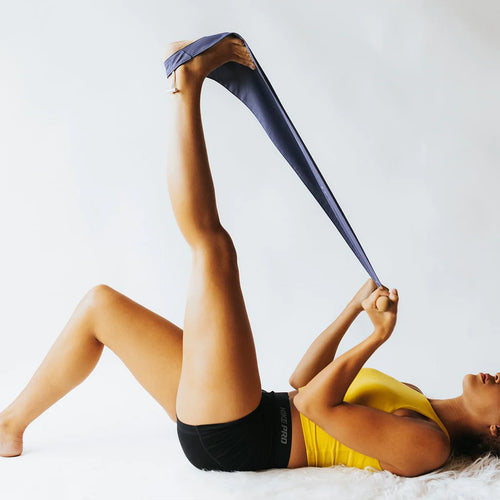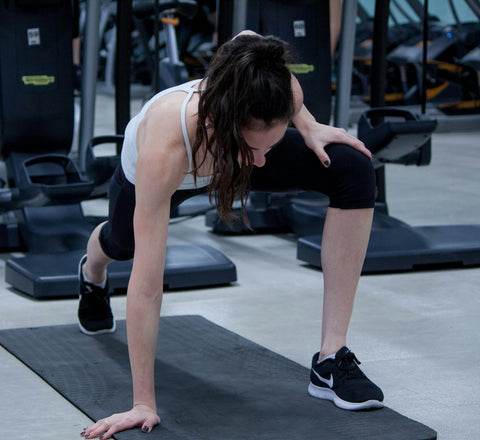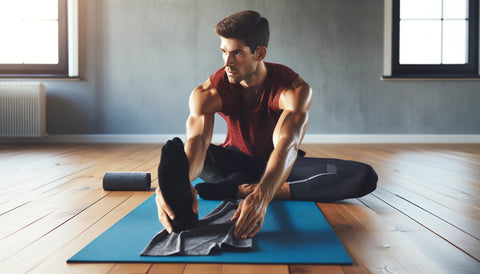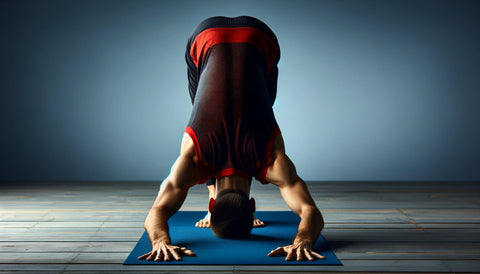Contents (Jump to a section)
How to Increase Ankle Dorsiflexion Range of Motion: Stretches & Exercises for Improved Mobility

- What is Ankle Dorsiflexion?
- Importance of Ankle Dorsiflexion
- Signs of Poor Ankle Dorsiflexion Range of Motion
- What is Normal Ankle Range of Motion for Dorsiflexion?
-
The Ankle Mobility Range of Motion Test (ROM)
- 5.1 Dorsiflexion
- 5.2 Plantarflexion
- 5.3 Inversion/Eversion
- 5.4 Interpretation
- Understanding the Factors That Influence Ankle Dorsiflexion
- How to Increase Ankle Dorsiflexion Range of Motion: Ankle Dorsiflexion Exercises & Stretches
-
The Top Ankle Dorsiflexion Stretches
- 8.1 Calf Stretch
- 8.2 Ankle Circles
- 8.3 Seated Towel Stretch
- 8.4 Downward Dog Stretch
- Top Ankle Dorsiflexion Exercises
- Parting Thoughts on How to Increase Ankle Dorsiflexion Range of Motion
If you struggle with activities that require you to move your foot towards your shin, like squatting or running, you may be suffering from poor ankle mobility. Ankle dorsiflexion range of motion is a common issue for many people, and it can significantly impact your ability to perform everyday tasks and pursue your fitness goals. Luckily, there’s a simple solution: stretching!
By incorporating stretches and exercises specifically designed to target your ankle dorsiflexion, you can increase your mobility and regain your confidence during workouts. In this article, we'll guide you through some ankle dorsiflexion stretches that will help you improve your ankle range of motion and get back to doing the things you love with ease.
Get ready to say goodbye to ankle stiffness and hello to a more flexible, mobile you with these ankle dorsiflexion exercises!
What is Ankle Dorsiflexion?
Ankle dorsiflexion is the movement that occurs when you bring your foot toward your shin. It is an essential motion for activities like walking, running, and squatting, as it allows your ankle to bend and your body to move forward smoothly.
Dorsiflexion is controlled by several muscles, including the tibialis anterior, extensor digitorum longus, and extensor hallucis longus, which work together to lift the front of your foot off the ground and towards your shin.
Importance of Ankle Dorsiflexion

Improving ankle dorsiflexion with ankle dorsiflexion stretches requires some dedication, as you need to stretch regularly to see results. So, why is it important to work on improving ankle dorsiflexion? Let’s take a look.
Enhanced Athletic Performance
Ankle dorsiflexion is a fundamental movement pattern in many sports and athletic activities. When you increase ankle dorsiflexion, you can increase your speed, power, and agility on the field or in the gym. You can find some general tips for how to increase ankle mobility to maximize your athletic performance in this guide.
Prevention of Lower Limb Injuries
Limited ankle dorsiflexion has been linked to a higher risk of lower limb injuries, such as ankle sprains, Achilles tendonitis, and even a tight hamstring causing knee pain. By improving ankle dorsiflexion, you can reduce your risk of these types of injuries and stay active and healthy for longer. If you do have a lower limb injury like shin splints, you might be interested in how to stretch shins and how long to heal shin splints.
Improved Balance and Stability
The ankle joint is a key player in maintaining balance and stability throughout the body. By increasing your ankle dorsiflexion, you can improve your body's ability to stabilize itself and prevent falls and other accidents.
Correction of Postural Issues and Movement Inefficiencies
Your ankle's ability to dorsiflex is critical for maintaining proper alignment and balance throughout your body. When ankle dorsiflexion is limited, it can cause compensations in other parts of the body, leading to issues like knee pain, hip dysfunction, and even back pain.
It's essential to maintain and improve ankle dorsiflexion with ankle dorsiflexion exercises to support your overall health and mobility.
Signs of Poor Ankle Dorsiflexion Range of Motion
Limited ankle dorsiflexion range of motion can have a significant impact on your daily life and athletic performance. Here are some signs that your ankle mobility may be limited:
- Difficulty Squatting. You may find it challenging to perform a deep squat without your heels lifting off the ground or your knees turning inward
- Foot or Heel Pain. Limited ankle dorsiflexion can cause pain or discomfort in the foot or heel, particularly during activities like walking or running
- Knee Pain. You may start to experience knee pain, as the knee compensates for the lack of ankle mobility during movement
- Poor Balance or Stability. Limited ankle dorsiflexion can make it difficult to maintain proper balance and stability when standing on one leg or walking on uneven surfaces
- Tightness in the Calves or Achilles Tendon. As these are involved in controlling ankle movement, they are commonly associated with limited ankle dorsiflexion
What is Normal Ankle Range of Motion for Dorsiflexion?
The ankle normal range of motion for dorsiflexion varies among individuals, but typically, it should allow the foot to move towards the shin at least 10-20 degrees. A healthcare professional or physiotherapist can assess your specific range of motion through a series of tests.
The Ankle Mobility Range of Motion Test (ROM)
Test is a physical assessment used to evaluate the flexibility and movement capabilities of the ankle joint. This test is particularly important for athletes, individuals involved in physical activities, or those rehabilitating from ankle injuries.
Procedure: sit or stand in a comfortable position with the legs extended or hanging off the edge of a surface.
How to do?
Dorsiflexion
With the knee straight, pull your foot and toes towards your body, aiming to bring the top of your foot closer to your shin.
Plantarflexion
Point your toes away from your body, trying to maximize the downward movement.
Inversion/Eversion
Turn your foot inward (inversion) and outward (eversion) to assess lateral movements.
Interpretation
Limited dorsiflexion may indicate tightness in the calf muscles or Achilles tendon. Restricted plantarflexion could suggest stiffness in the muscles at the front of the ankle.
Difficulty with inversion or eversion may indicate issues with lateral ankle stability.
Understanding the Factors That Influence Ankle Dorsiflexion

Several factors can influence ankle dorsiflexion. Understanding these factors can help you identify potential areas for improvement and learn how to increase ankle dorsiflexion. Here are some of the most significant factors to consider:
Joint Structure and Alignment
The structure and alignment of your ankle joint can affect your ankle dorsiflexion. Some people naturally have more mobility in their ankles due to differences in bone structure or joint alignment. On the other hand, others may have limited ankle mobility due to factors like arthritis or joint degeneration.
Muscle Flexibility and Strength
The flexibility and strength of the muscles surrounding the ankle joint can also affect ankle dorsiflexion. Tight or weak muscles, like the calves or anterior tibialis, can limit ankle mobility, while strong and flexible muscles can support a greater range of motion.
You may want to learn how to release tight calves and how long does it take to improve flexibility if tight or weak muscles are affecting your ankle mobility.
Prior Injuries and Medical Conditions
Previous injuries or medical conditions, like ankle sprains, plantar fasciitis, or Achilles tendonitis, can limit ankle dorsiflexion. Scar tissue and adhesions can also contribute to limited mobility in the ankle joint.
Shoe Choice and Foot Support
The shoes you wear and the support they provide can impact your ankle dorsiflexion. High heels, for example, can limit ankle mobility, while supportive shoes with a stable heel and arch can promote proper alignment and help to improve ankle dorsiflexion.
How to Increase Ankle Dorsiflexion Range of Motion: Ankle Dorsiflexion Exercises & Stretches
Improving ankle dorsiflexion is essential for enhancing athletic performance, reducing injury risk, and improving overall mobility. Let’s now dive into how to increase ankle dorsiflexion with exercises and stretches.
Warming Up the Body Before Performing Ankle Dorsiflexion Stretches
It's crucial to warm up before performing any stretching or exercise routine. Your warm-up could be light cardio like jogging or jumping jacks, or dynamic stretching exercises that target the legs and ankles. Try adding some stretches for tight glutes for your upper legs as well.
Best Practices for Stretching & Exercising to Improve Ankle Dorsiflexion
When you’re learning how to increase dorsiflexion, it's important to start with gentle, low-impact movements and gradually increase intensity and duration over time. Remember to breathe deeply and avoid any movements that cause pain or discomfort.
Stretching equipment like the CastleFlexx can help you to improve ankle dorsiflexion much more effectively than simply stretching on your own. The CastleFlexx is a lightweight, portable stretching device with a revolutionary design that allows you to stretch more effectively than ever before.
Not only is the CastleFlexx easy and comfortable to use, but it’s also designed to give you the benefits of assisted stretching without needing to invest in expensive physical therapy or gym equipment.
If you’re wondering how to increase ankle dorsiflexion, the CastleFlexx is the only stretching device you need. You can even learn how to fix tight hamstrings and how to increase hip mobility with the CastleFlexx.
The Top Ankle Dorsiflexion Stretches
One of the best ankle dorsiflexion stretches you can do is a calf stretch with the CastleFlexx. This stretch targets the gastrocnemius and soleus muscles of the calf, which can restrict ankle dorsiflexion.
To stretch your calf, lie on the floor with your feet on the ground and knees bent. Put one foot inside the CastleFlexx, with your toes pointing towards your face. Gently pull your foot toward your torso, keeping your knee straight, until you get to a 90-degree angle. Hold the stretch for around a minute, then move to the other leg.
Another option is ankle circles, a dynamic stretch that can help warm up the ankle joint and improve ankle mobility. Stand with your feet hip-width apart and place your hands on your hips. Lift one foot off the ground and make circles with your ankle, first in one direction and then the other. Repeat for 10-20 repetitions and then switch to the other foot.
Calf Stretch

To stretch your calf, lie on the floor with your feet on the ground and knees bent. Put one foot inside the CastleFlexx, with your toes pointing towards your face. Gently pull your foot toward your torso, keeping your knee straight, until you get to a 90-degree angle. Hold the stretch for around a minute, then move to the other leg.
Ankle Circles

Another option is ankle circles, a dynamic stretch that can help warm up the ankle joint and improve ankle mobility. Stand with your feet hip-width apart and place your hands on your hips. Lift one foot off the ground and make circles with your ankle, first in one direction and then the other. Repeat for 10-20 repetitions and then switch to the other foot.
Seated Towel Stretch

Sit on the floor with your legs extended. Loop a towel around the ball of one foot and gently pull it towards you, feeling the stretch in your calf and ankle.
Downward Dog Stretch

Start in a plank position, then lift your hips towards the ceiling, forming an inverted V-shape. Pedal your feet to stretch and mobilize the ankles.
Top Ankle Dorsiflexion Exercises
As well as ankle dorsiflexion stretches, ankle dorsiflexion exercises like heel raises, ankle pumps, and wall sits can help improve ankle dorsiflexion. These exercises can be performed using body weight or with the added resistance of the CastleFlexx.
One of the best ankle dorsiflexion exercises is the wall ankle mobility drill, which targets ankle mobility and can help improve ankle dorsiflexion.
Wall Ankle Mobility Dril
Stand facing a wall with your toes about an inch away from the wall. Lean forward and touch your knees to the wall, keeping your heels on the ground. Slowly move your feet back, keeping your heels on the ground, until you feel a stretch in the ankles.
Hold the stretch for 2-3 seconds and then return to the starting position. Repeat 10-20 times.
Resistance Band Dorsiflexion Exercise
Sit with your legs extended and loop a resistance band around the top of your foot. Pull the band towards you, resisting the movement with your foot to strengthen dorsiflexion.
Inverted Ankle Mobility Drill
Sit on your heels with toes pointed, lift your knees off the ground, and lean back onto your hands. This dynamic drill enhances ankle mobility.
Alphabet Toe Exercise
While seated or standing, lift one foot and "write" the alphabet in the air with your toes. This improves ankle flexibility in various directions.
Eccentric Heel Drops
Stand on a step with your heels hanging off the edge. Slowly lower your heels below the step, then use the other foot to return to the starting position. This eccentric exercise strengthens ankle dorsiflexors.
Progressing Ankle Dorsiflexion Stretches and Exercises
As you learn more about how to increase dorsiflexion and become more comfortable with ankle dorsiflexion stretches and exercises, you can gradually increase the intensity and duration of your routine. This might include using heavier weights, increasing the number of repetitions, or holding stretches for longer periods.
Improving Ankle Dorsiflexion With Deep Tissue Mobilization
Just like fascial stretch therapy with the CastleFlexx, deep tissue mobilization techniques, like foam rolling or massage therapy, can help loosen tight muscles and increase ankle dorsiflexion. These techniques can be performed before or after stretching and ankle dorsiflexion exercises.
Parting Thoughts on How to Increase Ankle Dorsiflexion Range of Motion
Now that you know how to increase dorsiflexion with stretches and exercises, you’ll be able to incorporate ankle dorsiflexion exercises and stretches into your regular workout routine. It’s definitely worth it - improved ankle mobility can help reduce your risk of injury and reach your full athletic potential.
Remember to warm up before performing any stretches, follow best practices for stretching and exercising, and progress gradually to avoid injury. The CastleFlexx can revolutionize the way you stretch and help you increase your ankle dorsiflexion much faster and more effectively than if you stretch without it. By precisely targeting the right muscle groups, the CastleFlexx will improve your ankle mobility in no time at all.
Help unlock your body’s full athletic potential. Order your CastleFlexx today!
